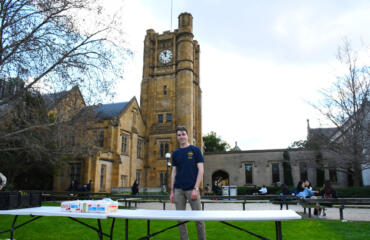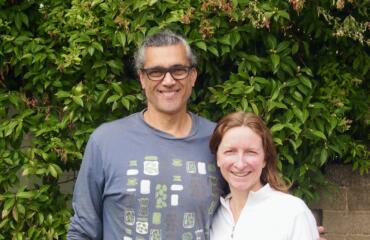
Mike and Therese Newbon have owned a dual business in High St, Northcote, selling an unlikely combination of wares – rare earth magnets and rugs – since 1994. Higher rates, less parking and younger faces are three big changes the duo have seen.
“When we started here, there was a lot of the older owners. A lot of the Greeks had homes they’ve lived in for 30-40 years. A lot of them have sold out because of the money, they’ve sold out and moved on. There’s a different crowd now,” says Mike.
The different crowd is affecting demand for the types of rugs the Newbons sell. “There are a lot of multi-stories going on so before we would sell a lot of big rugs and now we sell more small ones,” says Therese. “All the Victorian houses used to have 12 metre hallway runners, now with the apartments we’re selling a lot less runners and a lot more smaller rugs.”
While the heyday of their business was the early 2000s, is a distant memory, the Newbons have no plans of moving.
“Twenty-five years on, this place has given us a house, a car. It’s part of us.”

A few doors down is Lobos Collectibles. It’s been selling vintage collectibles and comic books for nearly 10 years. According to Aron Challinger, who has been the store manager since the doors opened, the constant stream of construction sites has brought food and life to the area.
“When we first came you couldn’t even get a sandwich. It was a ghost town. Now, there are so many restaurants it’s hard to choose,” he says.

Leap up High Street to Preston where Lucchini’s has been serving the local community since 1973. The Italian cake shop has been owned by the same family for three generations.
“It’s changed in a way. Some of the people are still the same, a lot of oldies are still around. But there’s a lot of new too, more Asian, Vietnamese, Chinese. Younger people and Muslims too,” says Gianni Menara, who’s been working in the café since he was a child.
Soy milk, gluten free cakes, chilled Vietnamese coffee and more vegetarian food are among the additions to the menu made by the Menaras to accommodate the changing clientele. And Gianni found himself, for the first time, taking an order for the very cake that preoccupied so much political discussion last year – providing the centrepiece for same sex marriage feast. But that didn’t phase the baker.
“My parents made a cake for a same-sex couple a few years back but that one was under wraps,” he says.
“Politically, it used to be Labor, Labor, Labor but that seems like something that might change soon,” says Gianni.
“The old Italian and Greeks who would never vote anything but Labor are slowly moving out of the area.”

Now in the Preston Markets, Nelly Rusten’s family has owned this flower store for 20 years. He has also noticed the older migrant generation moving out of the area but says the younger generation has been good for business – fewer lillies and less demanding customers.
“The older Europeans wanted the more traditional flowers. They just wanted lillies. Lillies, lillies, lillies, that’s all people wanted. Now people want more unusual sorts of things, wild flowers, those that look more natural,” says Nelly.
“The older Euros were a lot more needy. That was our fault as well because we’d tend to their needs.
“It’s getting better though, the younger generation are a lot more laid back.”

Frank Papaluca has owned Joe’s Quality Corner, a butcher’s shop in Preston, for 32 years. Over this time, he says the area is “totally different to what it was before”.
“Before it was either your Aussie or your European. But now there’s a big difference, Asian, Chinese, Japanese, Indian, the mixture of people is unreal at the moment.”
He’s had to keep business booming by stocking different types of meat to cater for the new cultural mixing pot.
“Now we do a lot of lamb and goat curries for the Indians, Sri Lankan, Nepalese.”
As for the organic-loving Green-voting stereotype, Frank says that hasn’t quite picked up yet.
“We’re stocking a bit of organic meat but the only issue with that in Preston is that it’s still not a very wealthy area, so it’s hard to sell organic stuff here because it’s just too expensive.”

On the other side of the market, Dominic has owned the MnM Fruit stall for 11 years. He says the apartment boom of Preston is to blame for the downfall of the traditional marketplace and the market owners are bending over backwards to draw in the younger crowd.
“They’re trying to attract a different type of people here.” But Dominic says there is no loyalty in the new crowd, whose buying habits tend to follow the prevailing winds of the trends of the moment.
“We’ve done a bit of the super foods but they’re not taking off because the hipsters are one-hit wonders. They’ll come today if it’s on social media but then they’ll go. There’s no loyalty.”
“That hipster aesthetic, they’re coming to the market but they’re not trickling through this way. There’s not enough of them to shift your business because they’re not coming here to shop.
“They’d rather spend $4.50 on a coffee rather than $2 on a punnet of strawberries.”



